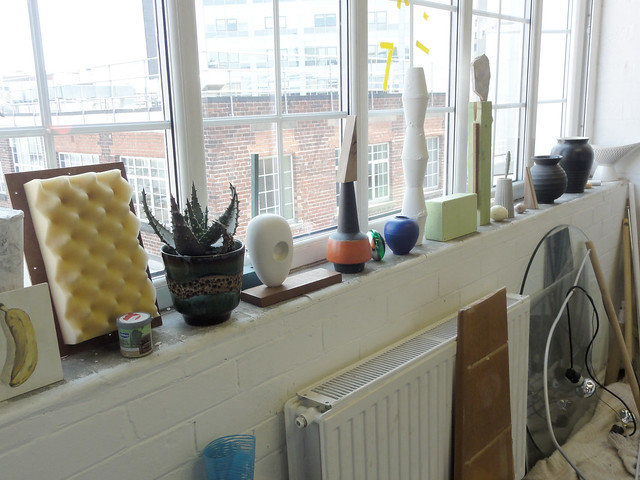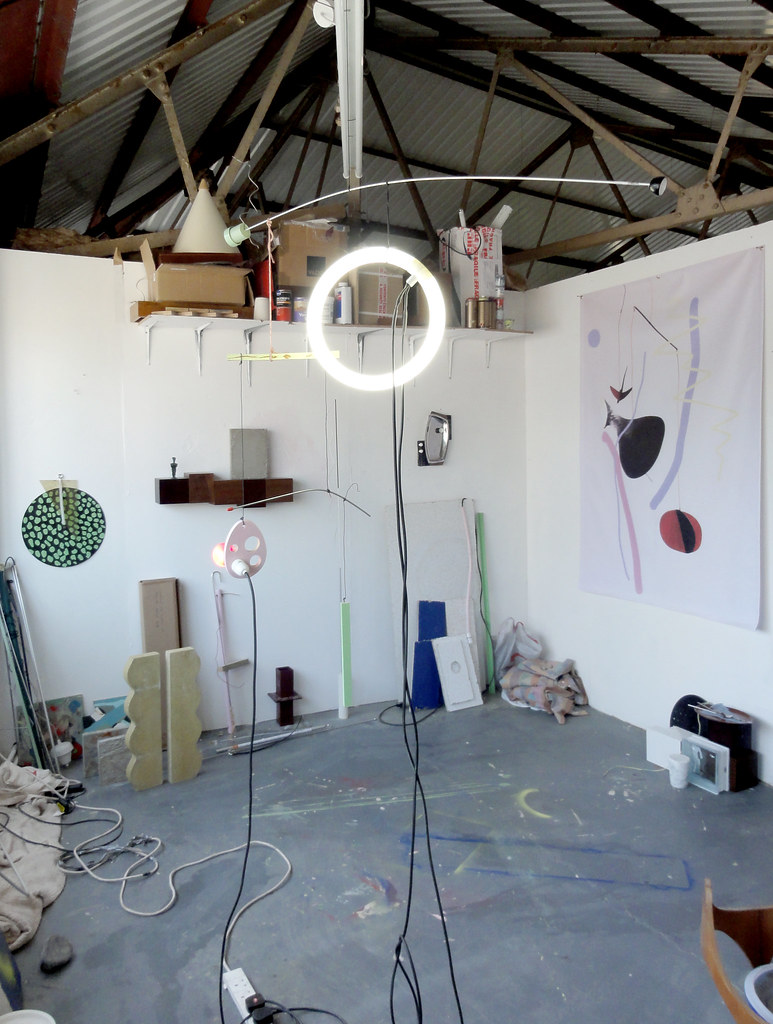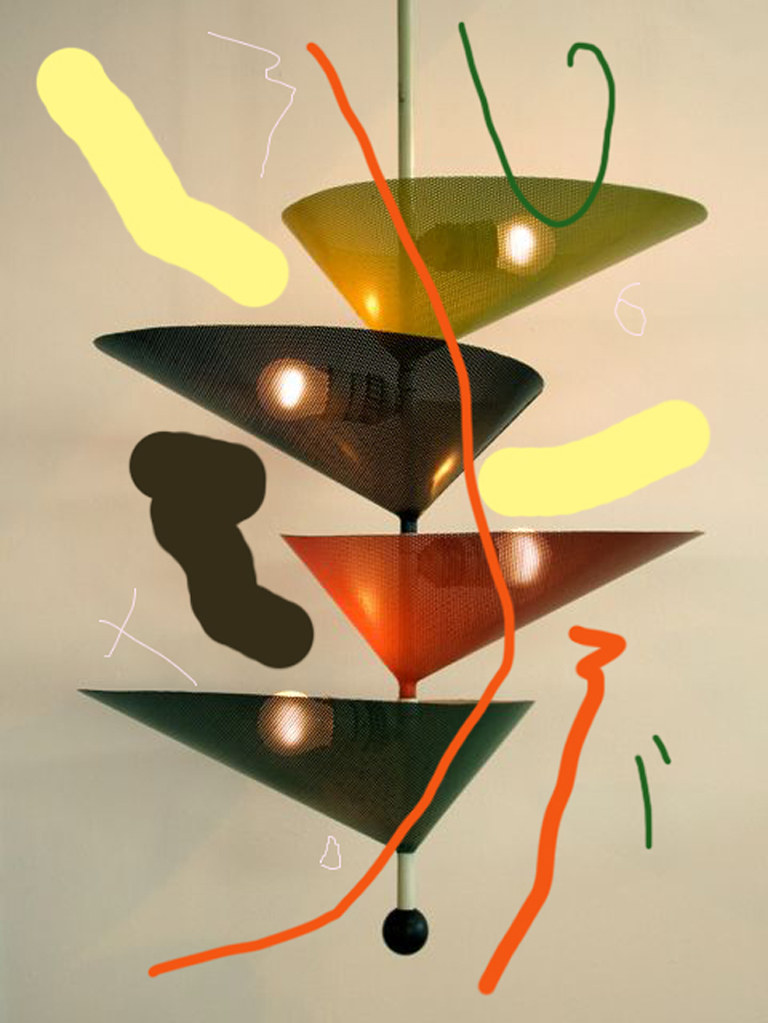" I think there are these chains of design history where an initial idea is made by one designer, and where he leaves it, another picks it up, and the process continues till you end up with this kind of inbred mutant object which has a very very rich in history. But its position, what you might call cultural value, is actually very low because its overly mass produced."
"What I want to do is try and address that by looking at the past and understanding why the graphics on my phone and the furniture on the high street look like elements of modernist abstract painting or a piece of Bruno Mathsson Furniture and highlight that."
-James Clarkson


top image:"Ordering of Colour and Form", Mixed Media, 2010
bottom image "A silver tear from a stone soul" 2010
"James Clarkson’s practice addresses a HEDONISTIC IDEALSIM surrounding modernist art, design and interior living. He creates sculptures and paintings, which act as references or cultural signifiers, exploring historical contradictions between high art & design and low-end mass production. He is interested in the relationship between form, functionalism and meaning as modes of value and experience. His work looks to the past as a means of understanding the way we live now, whilst retaining an ambiguity for past, present and future"
YHBHS: "Hedonistic Idealism" Do you idealize the past? There is a strong emergence of young artists and designers being energized by the works of furniture designers and sculptors that range from Sottsass, Brancussi, Superstudio, to name a tiny few. Will you talk about this in relation to your work?
JC: I think when I used the term "hedonistic idealism," I was trying to talk about what you are describing as, ‘the strong emergence of young artists and designers.’ What I want to do is try and address that by looking at the past and understanding why the graphics on my phone and the furniture on the high street look like elements of modernist abstract painting or a piece of Bruno Mathsson Furniture and highlight that.
I think there are these chains of design history where an initial idea is made by one designer and where he leaves it anther picks it up and the process continues till you end up with this kind of inbred mutant object which has very very rich in history, but its position, what you might call cultural value, is actually very low because its overly mass produced. A good example of this is the West Germany Pottery Group. I am really interested in those systems of value and how they can be broken down into objects. I try and use elements of these objects, formally, in my sculptures. A lot of the time these objects will have some form of visual manifesto that makes them distinguishable, whether that be a certain wavy line or some form of patternation.
You are right though there is an incredibly large amount of artists practicing like this at the moment it can be quite overwhelming really. Some of my favourites though are Mathew Dearbyshire, Martin Boyce, Eva Berendes, George Henry Longley, Karin Ruggaber and Giles Round. I also worked as an artist assistant to Haroon Mirza, whose practice works slightly differently to the others above, but this was hugely key to the way I have developed as an artist. I started work form him more or less straight after university, the process became like a second education, which I was very grateful for.
You mentioned that your father collected antiques. What sort of antiques did he collect? Any specific items, were there any as a kid that captivated your imagination?
He still collects antiques now, so whenever I go home I find it an incredibly exciting time, things that I really like will have been moved on and in their place something new. It was much like this when I was a child. There would always be new things moving through the house, a lot of ceramics and sometimes furniture.
My dad once had a Bruno Mathsson chair, which is something I remember quite vividly, as well as a really large collection of Franz Hagenauer Bronzes. Both have gone now and one of the only things that lives on from when I was younger is his collection of rare Poole Plane Ware. As a child I was really fixated by everything we had and how it was so different to a lot of other things I would see on a daily basis. Now I am really interested by the idea that the legacy of modernism is something we have to live with on a daily basis. My father collecting these things made that a really smooth transition and when I first started to make artwork my concerns were always with this in mind, one way or another. A lot of the things I saw around me just seemed so lodged in the modes of thinking behind modernism or were forming a very rigid language around it, I saw something really positive in that, but never really put much thought into it until now.
How important is "tension" in your work?
I guess tension is something that is physically present in a lot of sculpture historically. It’s not something that I put a lot of thought into when making work. I am more concerned with formal arrangements of line and the balance between objects, sometimes this might create a physical tension, but it could be totally incidental and I really like that kind of thing happening.
I do think of tension in a more conceptual way though. The tension between sculpture and abstract painting is particularly important in the way I go about making my work. In particular the teachings of Josef Itten, at the Bauhaus school of art and design during the year of 1931. Itten made his students dismantle an object placed in front of them into a painting its basic formal Shapes and colours. The painting would then be used as an instruction for the creation of furniture or sculpture. Recently I have been using this process with a lot of the works I am making for an upcoming exhibition. Working like this allows the process of making to implement an environment where potentially there isn't much difference between the object and its surrounding material, or where that interaction is entirely alluded to through nuance, abstractions and conceptual activity.
YHBHS: What are you ideas of what a "home" or "interior space" should be? I read in an interview that you are fascinated with the Frey House II. Can you talk about your interest in that home?
JC: What I find particularly interesting about the Frey House II is its harmony within the environment it sits. The way the clean, straight edges seamlessly balance the giant rock that intersects the window; it makes the whole thing quite sculptural. Especially when you transfer that into a photograph, it looks very strange, almost not real, I like that. So perhaps the Fr
 ey house is not really somewhere I would like to live, perhaps just visit a couple of times.
ey house is not really somewhere I would like to live, perhaps just visit a couple of times.My idea of what an ‘interior space’ should be in regards to the ‘home’ is probably something more like Gio Ponti’s Residential Building Via Dezza. I think its quite liveable space, its not huge, but realistic in regards to functioning properly for a human being. The only thing it misses is a garden, I think outdoor living space is as important as the interior.
I really like Le Courbusier’s Surrealist Garden for the Charles de Beistegui Apartment and all the outdoor spaces Caesar Manrique built. Again I think I like these space more because of their focus around sculpture, they are both really private spaces too, which I think adds to their charm. Perhaps this is really what interests me about the Frey House II also. The line is really blurred between interior and exterior space, in fact the two become totally combined.
"Mategot Composite", 2011, and your other collages. Where did the ideas originate, and how are they different from your sculptures?
I like to think of the works you are referring to as paintings, done in the same light as those of Itten’s students at the Bauhaus. The markings act as an abstraction of the ‘Masters’ work and form an instruction for a set of sculptural works. In my upcoming exhibition, at Supercollider, I have taken an image of a Calder work and used this process of abstraction to create of body of sculptural works that in their presentation reference this. Its kind of an attempt to make the creating process a bit more transparent and also about trying to work with these images as found objects.
What’s important about these images of the ‘Masters’ work is that they all come from sale or private collection catalogues. I think this really changes what the art work or design object depicted stands for, making them really empty and hollow, kind of like a blank canvas in some respects. Yet there is also something incredibly spiritual about the way the objects are prented in the photogrpahs, lit and placed in endless white artificially lit environments. The images are so different to how you would perceive the work in reality, yet they really retain a real sense of their sculptural form.
YHBHS: I completely agree with you. On YHBHS, I have often considered whether I am studying "the object as a photo" or "the object as a historical object." My head spins in circle some mornings as I sort what I am looking at & thinking about. It's the context I continually attempt to understand.
When paging through the glossy & gorgeous auction catalogs, and then making it to the actual viewing, there is sometimes a sense of a let down, or perhaps a reality check. The objects come alive in person, sometimes for the better, and sometimes for the worse.
But there is also the joy, in coming to terms with these objects, and their history as objects. Hopefully, they have been used, and enjoyed, as a design object should be. The fading of the metal, the reflection, the dust on their surfaces tells a story. I find it interesting in your practice of sculpture and photo-based collages, that you are working with these ideas.
Ok, back to the questions! If you had to choose, only one, Form or Function?
I think it would be form every time. I have this really old Ikea sofa at home, which I think is really stylish. When it was available initially I think it was pretty low cost, its not very functional either. My partner is always on at me to throw it out and get a new one but I value it formally far too much. Although if I had more money I would just buy a more expensive better looking one!
Can you talk about the art/design scene in Sheffield/Manchester? Any favorite art galleries we should know about in Sheffield?
I have lived in Sheffield for about four years now and have seen the art scene shift around quite a bit. The art galleries are a bit bigger than they used to be and there seems to be a real drive forwards in terms of Sheffield’s reputation as a place for exciting new work by international artists. The art scene in Manchester seems to be much the same, although the focus is perhaps on a different type of art practice, which I think is a positive thing, its not always good to be singing from the same hymn sheet. The north of England has been a bit pushed out by the south in terms of the arts in the past, but it feels like that’s about to change slightly with new galleries like; The Hepworth Wakefield and the recently re-opened S1 Artspace driving that force with some of the deep rooted spaces like Site Gallery and The Henry Moore Foundation driving the force.



images of James Clarkson's studio
James Clarkson, shows....
Supercollider UK, July 10 - July 31.
"Surface Open", Surface Gallery, Nottingham, July 12 - 30
"How to be a Magician in Your Spare Time", Kunst Projects, Berlin, Summer 201
James Clarkson portfolio here...
(thank you James for this conversation......)

---------------------------------
You have read this article james clarkson /
kunst projects /
supercollider /
surface gallery /
yhbhs conversation with james clarkson /
YHBHS interview
with the title YHBHS interview with James Clarkson. You can bookmark this page URL http://gigibytes.blogspot.com/2011/07/yhbhs-interview-with-james-clarkson.html. Thanks!








No comment for "YHBHS interview with James Clarkson"
Post a Comment